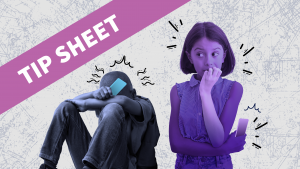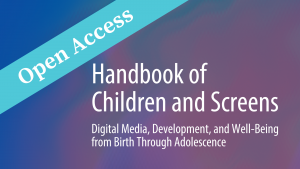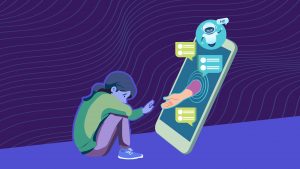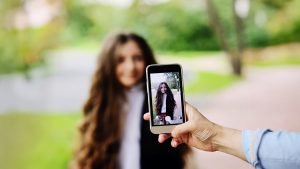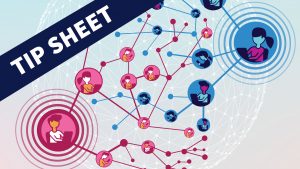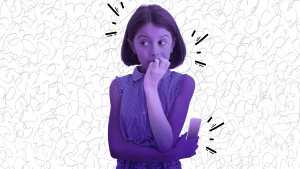
We’ve all seen the news: rates of anxiety and depression in adolescents have reached alarmingly high levels in recent years. What relationship does digital media use have with anxiety disorders in youth? What are the risk factors for developing anxiety, and what prevention and intervention strategies can parents, caregivers, educators, and clinicians employ to help children build resilience to online and offline stressors?
Children and Screens hosted the “Ask The Experts” webinar “Anxiety: Youth Mental Health and Digital Media” on Wednesday, October 4, 2023, the first in a set of webinars investigating two of the most common mental health struggles of youth today: anxiety and depression. A panel of clinical psychologists, child and adolescent psychiatrists, and other experts in anxiety disorders shared clinical insights and research on the prevalence of youth anxiety and how digital media use may be contributing to it, as well as tips on how adults can support the children in their lives who may be suffering – or at risk of developing – anxiety.
Speakers
-
Sandra Whitehouse, PhD
Senior Director, Senior Psychologist, Anxiety Disorders Center, Child Mind InstituteModerator
-
Erin Berman, PhD
Clinical Psychologist, National Institute of Mental Health
-
Sandra Fritsch, MD
Medical Director, Pediatric Mental Health Institute, Children’s Hospital Colorado; Medical Director, CoPPCAP (Colorado Pediatric Psychiatry & Consultation Program); Professor, Department of Psychiatry, University of Colorado School of Medicine
-
Sarah Myruski, PhD
Assistant Research Professor in Psychology, Associate Lab Director, Emotion Development Lab, Pennsylvania State University
-
Henry Willis, PhD
Assistant Professor, Clinical Psychology Program, University of Maryland, College Park
Resources Mentioned During the Webinar
- Screen Time vs. Lean Time Infographic (Website/Report)
- ADAA Children and Anxiety and Depression Resources (Report/Toolkit)
- Born This Way Foundation (Organization Website)
- Arcade Therapeutics (Organization Website)
- Behind Their Screens: What Teens Are Facing (And Adults Are Missing) (Website/Book)
- Future Tense: Why Anxiety is Good For You (Even Though it Feels Bad) (Website/Book)
- Do Yoga With Me (Organization Website)
- Exercise for Mood and Anxiety: Proven Strategies for Overcoming Depression and Enhancing Well-Being (Book)
- The Greater Good Science Center Mindfulness Meditation Practices (Website/Toolkit)
- The Mindfulness Revolution (Book)
- Fully Present (Book)
- The Happiness Project (Website/Book)
- AHA Advice, Recipes, and Nutrition Guides (Organization Website)
- Find a Cognitive Behavioral Therapist (Organization Website)
- Department of Child & Adolescent Psychiatry Resources (Organization Website)
- Worry Wise Kids (Organization Website)
- Coping Cat Parents (Children's Anxiety Resources) (Organization Website)
- Helping Your Anxious Child: A Step-by-Step Guide for Parents (Book)
00:00 Introduction
Kris Perry, MSW, Executive Director of Children and Screens: Institute of Digital Media and Child Development, introduces the webinar and panel moderator, Sandra Whitehouse, PhD, Senior Director of Anxiety Disorders Center at the Child Mind Institute. Dr. Whitehouse introduces the main topics of the webinar, highlighting potential screen use concerns and how they may relate to anxiety in youth.
7:31 Sandra Fritsch, MD
Sandra Fritsch, MD, Medical Director of the Pediatric Mental Health Institute at the Children’s Hospital Colorado and Professor in the Department of Psychiatry at University of Colorado School of Medicine, provides a rundown of the current pediatric mental health crisis and how it is related to screentime. Dr. Fritsch describes what parents should consider when analyzing their children’s screen use and its impact on their wellbeing, including physical activity, sleep, important developmental tasks, and possible uses of digital media as treatment.
21:27 Sarah Myruski, PhD
Sarah Myruski, PhD, Assistant Research Professor in Psychology at Penn State and the Associate Lab Director in the Emotion Development Lab, provides insights on how digital media use may impact anxiety and emotional regulation in teens. She summarizes two research studies about the pivotal role of emotion regulation in the relationship between digital media uses and risk of anxiety. At the end of her presentation, she offers recommendations for how parents can improve emotional regulation and reflect on healthy digital media uses.
33:33 Henry Willis, PhD
Henry Willis, PhD, Assistant Professor of Clinical Psychology at the University of Maryland, College Park, discusses research on risk and resilience factors associated with teen digital media use and anxiety, focusing on Black youth and youth of color. He describes specific risks that youth of color face online, such as online racism and traumatic race-related content, and how these experiences relate to higher rates of anxiety among youth of color. He provides examples of how this anxiety might present in youth, specific protective factors for youth of color, and relevant considerations for both intervention and prevention.
46:25 Erin Berman, PhD
Erin Berman, PhD, Clinical Psychologist at the National Institute of Mental Health, begins by addressing some need-to-know information about anxiety. She describes the main symptoms of excessive anxiety, when anxiety becomes a disorder, and physical symptoms of anxiety to look out for. She offers “what to do” and “what not to do” tips for caregivers with children who struggle with anxiety, how to respond to a panic attack, and strategies to support children in building resilience against anxiety.
58:58 Discussion and Q&A
Guided by Dr. Whitehouse, the panelists answer questions about how to talk with youth about balanced digital media use, impacts of active vs. passive screen use, and managing school-related device time. Panelists also give advice on how to balance smartphone use to create healthy sleep patterns and finding a community that values healthy use as well. The panelists wrap up the webinar by providing recommendations for online safety and emphasize the importance of having open, curious conversations about technology.
[Kris Perry]: Hello and welcome to our 65th Ask the Experts webinar. Anxiety, Youth Mental Health and Digital Media. I am Kris Perry, Executive Director of Children and Screens Institute of Digital Media and Child Development. The current youth mental health crisis is a concern for all of us. Rates of anxiety and depression in youth doubled during the COVID-19 pandemic, but they were already climbing before 2020 and have remained alarmingly high. There are a number of factors contributing to these increases, but over the next two webinars, we will look specifically at the role of technology and digital media in youth mental health. Today’s webinar will be focused on anxiety and we have brought together an expert panel of clinical psychologists, pediatric psychiatrists and researchers.Together, they will explore the relationship between digital media use and anxiety in youth, specific risk and protective factors and key prevention and intervention strategies that you can employ with the youth in your lives. Through their presentations, and a group discussion at the end, the panel will try to answer as many of your questions as they can in the time allotted. Moderating today’s session, we are thrilled to welcome Dr. Sandra Whitehouse. Sandra is the senior director and senior psychologist in the Anxiety Disorders Center at the Child Mind Institute. She has over 25 years of experience evaluating and treating childhood conditions, including learning, Autism spectrum behavioral and emotional disorders. She also retains her appointment as an adjunct assistant professor in the University of Utah’s Department of Psychiatry. Welcome, Sandra.
[Dr. Sandra Whitehouse]: Thank you, Kris. So as Kris said, today’s topic for our webinar is anxiety, youth mental health, and digital media and our aim is for attendees to take away a mixture of what the research says, clinical advice, and concrete practical tips for parents, educators, researchers, and clinicians. So as we consider this topic, I thought starting with the idea of screen use disorders and anxiety would be useful. And I put in the word disorders there because I think it’s time that we start to wonder, is there addictive potential with screen use, with the consumption of digital media? We know we have substance use disorders. Is it time to consider that we may now be raising a generation of children and teens who are prone to screen use disorders? Indeed, a majority of parents are concerned that their child or teen may spend too much time on screen. And while parents are confident in their ability to know how much screen time is appropriate, it’s hard for them to set those limits in place, and increasingly, that confidence is being eroded. Parents tend to seek advice and information about screen time from doctors, medical professionals, other parents, teachers, online, blogs, books and magazines, online message boards and webinars so you’re in good company here. When we think about typical screen use, what parents often don’t know is if you have a child on your cell phone plan, on your Internet plan, chances are good you can actually view their screen time. And so I’ve got an example here where with either an Apple phone or an Android, you can take your phone, you can go into the settings and if you have an Apple, you’re going to be going into screen time, Android, digital wellbeing and parent controls and from there, you scroll down to either family and your child’s name or show your data and you can see your child or team’s activity. On the right, you can see an example of a parent’s iPhone and this is a parent who’s taking a look at their child’s screen time, and they’ve got a couple of days they can look at for this week. Really, they’re looking back over the past week. So they’ve got a week at a glance and they can see that their child spent an average of 6 hours and 22 minutes on screen for a grand total of 44 hours and 39 minutes for that week, which is more than a full time job. Right? And this is above and beyond what that child might be doing on their Chromebook for school, TV, movies, etc.. This is just on their phone. Does not include PlayStation or Xbox. So the screen time features that monitor this on your phone will also tell you about what the breakdown is. And so the top three for this child is social about 21 hours on social. Also a good chunk of time on games and other entertainment. So it’s good for all parents to know that they can and should check and see how much time their child has been spending on their phone, not just on other devices. Is screen use a concern? Well, it turns out even teenagers admit that they’re concerned about their screen use. So about 44% of teens admit that they struggle to take a tech break. They have FOMO right? They’re afraid they might be missing out on something important that’s going on socially, usually with groups of friends or people they follow. This continues into adulthood, with our young adults spending an average about 45 hours or more per week looking at a screen above and beyond what’s required in their jobs. U.S. teens are on screen for more than 7 hours a day for entertainment and about half feel addicted to their smartphones. Turns out this is by design. We get bursts of feel good neurochemicals when gaming, shopping or gazing at social media, and that’s built into the platforms to create a generation of consumers. So as an example here on the right, think about how you might advise these parents who are very proud that they’ve limited their child’s gaming and screen use to weekends only and or gaming to weekends only. And they don’t allow cell phones during meals. And so suddenly when they put in this limit of no cell phones during meals, their child develops what appears to be a bladder problem and he’s up and using the bathroom every 15 minutes. Of course, he does have his phone in his back pocket. So think about what you want to advise these parents as they consider. Is this something they need to bring their child to the doctor for, or might they first think about other ways to more effectively limit that screen, which might include actually removing the device? So I think that that paves the way for our presentation, our panel presentations here, screen use influences our children and teens. They are influenced by influencers and it is shown to increase anxiety. In our example with the child at the dinner table. He’s anxious he might be missing out. He’s anxious that he is letting down player multiplayer his players on his multiplayer games. It’s also influencing children in myriad other ways that our panelists will present and talk about. So leading into our first panelist, I’d like to introduce Dr. Sandra Fritsch, who is the medical director of the Pediatric Mental Health Institute Children’s Hospital, Colorado, as well as of the Colorado Pediatric Psychiatry Consultation and Access Program. In addition, she is professor in the Department of Psychiatry at the University of Colorado School of Medicine. Her career has encompassed working at the interface of pediatrics and child psychiatry, both for inpatients in pediatric hospitals and an outpatient child psychiatry. Dr. Fritsch’s professional interests include advocacy innovations in medical education, collaborative care models between primary care and mental health providers, the impact of virtual technology on youth and mental health, and the interplay of physical health concerns and mental health needs. Welcome, Sandra.
[ Dr. Sandra Fritsch]: Thank you, Sandra. We must be of the same generation to both be called Sandra. It’s a pleasure to be here with part of Children and Screens. So thank you very much for this opportunity. Ironically, I was on call last evening and got a call about a 15 year old who had presented to the emergency room after her cell phone broke and was told that they weren’t going to replace it. That led to emotional and behavioral dysregulation and an emergency psychiatric evaluation. This happened just last night. If we could go to my disclosures, please. Okay. So as Sandra said, my employers, the University of Colorado School of Medicine, if you looked me up, you would find out I’m an unpaid board member for the National Network of Child Psychiatry access programs. But most importantly, I raised, through this changing time, a 23 and 24 year old currently and have lived experiences of raising them from Baby Einstein, Baby Mozart, Webkins world to Super Mario Brothers to then as my kids were teens having Snapchat available and the impact of that. So we all learned together during that time which then led to this being a professional interest of mine as well. Next, please. So Kris, when she was presented discussing this, talked a bit about the fact that there’s a pediatric mental health crisis. I was first a broadcaster announced or recognized through my own institution, Children’s Hospital of Colorado, back in May of 2021. And this was secondary to untold numbers of children presenting to emergency room seeking care. And this then led to a group of folks, the Children’s Hospital Association of the American Academy of Trauma and Psychiatry and American Academy of Pediatrics, announcing a pediatric mental health crisis back in October of 2021. The good news is this brings awareness to the fact that our kids need help, but it doesn’t change the fact that we are in a crisis and much of the impact of the fires in Maui has led to further worsening challenges in the Hawaii area. Next slide, please. So I will say, though, that there was a child mental health pandemic that predated the COVID-19 pandemic. This has been secondary to noted workforce shortages, but we have seen rising rates of depression, anxiety and suicide that have greatly increased since the pandemic. From my treatment, evaluate patient and care standpoint, there’s often limited training for our pediatric primary care providers to both assess and treat. But then, what has been the impact of digital technology and increased screen time? Whether it’s healthy, or not healthy, on lifestyle and how that has then impacted the worsening aspects that we’re seeing in child mental health. Next, please. So the increase in anxiety, this is predating the pandemic. And if you look at the left side of the screen, those are rates of anxiety in youth at between 2016 and 2020. And as you can see, it really did grow significantly even between 2017 and 2020. Going along with that also has been an overall decline in physical activity for our youth, ages 6 to 17. Next. So you think that is the most common behavioral health condition? Roughly up from 3 to 4 years of age, up to 12 years of age, you can see 5 to 10% of our kiddos suffering from anxiety symptoms. And by the time you hit the teenage years, it’s up to 25%. What is the impact on screens on that rising expression of anxiety and our youth unfortunately with the increased use of screen time and increased anxiety is a correlation, but it doesn’t necessarily mean a causation. So how do we understand this and what do we do about it? The other thing with screen use, everyone now is exposed 24 hours a day, seven days a week to the news, whether it be good news, bad news uncurated news. When I was growing up, it was a 30 minute half hour time for the weekly, the national news every night on TV. And that’s what we were exposed to unless you read the newspaper. But now our youth are exposed to it constantly. Next. This is just an infographic looking at different ages of screen time versus lean time. And this was put out through the CDC with the hyperlink, you can link on to it. So if you look at on the left, youth ages 11 to 14 are spending 9 hours a day, 8 to 10 years of age, 6 hours a day and 15 to 18, seven and a half hours a day with screen use. Next, please. What else is seen as the the the correlation of shortened sleep amongst our youth? This is from two different sources. The one on the left is the National Youth Risk Behavior Survey, which is actually a survey to the teens answering the questions on an average school night. How many hours of sleep do you get? And the one on the right is answered by parents. And all of these will be available to you afterwards if you want to explore them more fully. So but we are seeing significant impact of not sufficient sleep for our youth from ages all the way through childhood into adolescence. Next, please. So when we look at studies regarding children, anxiety, and screens, we don’t have an awful lot of prospective studies, but luckily we’ve got some folks who are doing the research on this this webinar today. We do know that problematic Internet use has been linked to less sleep, less physical activity, less outside time. And a lot of the studies looking at screen time and anxiety and youth is also studied together with depression. So it’s hard to tease out anxiety separately. Next. So we have developmental tasks. Sorry about the thing on the slide, but that we all are required to do as we go through childhood. And then how does that happen for anxiety? One of the things from infancy to toddlerhood that we want to see is separate successful separations from caregivers. In school age, kids making friends, being social is a developmental task. If you’re not successful with that, you then might develop social anxiety. You can have specific worries, fears and phobias. And by the time you hit the teenage years, part of that developmental task is figuring out who you are as a person, including what is your gender, what is your romance? How are you going to self present to others? What are you going to share with others? And weaving into meeting those developmental tasks successfully is the need for imaginary and creative play and how does screen time and screen use impact developmental tasks. Next slide please. This is just a slide looking at both risks and benefits for online habits for youth and anxiety with problematic internet use on the left, and potential benefits of being able to safely explore and express oneself, practicing self-disclosure, being able to access health related information, destigmatizing mental health forums. But on the left side, a lot of the problematic internet youths use which can relate to anxiety. Next, please. And how is technology in treatment of anxiety happening now? Youth are using online resources to get information and post and learn and track their data regarding health goals. Virtual reality is coming on board as far as for treatment. We also have mobile health apps. Unfortunately, many of those have not been studied. And then there’s electronic health supports to help support treatment. Next, I know I’m running a little bit late. So in summary, it’s really important to have an understanding of what is the type and what is the frequency of online activities that our youth are involved in. We have learned that if your active versus lurking and passive, active might be more protective compared to passive, where there might be greater risk, what is the actual emotional valence of the materials and sites being perused? So as Sandra talked about, she was able to show the amount of time, But where are you going? What are you using? And how is that balance of screen time, physical activity and sleep being played out? And does use of screen time demonstrate either positive or void in coping skills? And what is our new post-pandemic normal going to be? It’s still evolving and process. So again, thank you for this opportunity to speak.
[Dr. Sandra Whitehouse]: Thank you, Dr. Fritsch. And a question that’s coming up is based on your presentation, how does a parent support setting those healthy boundaries and rules with using tech and set up a tech time and a non-tech time for children and themselves?
[Dr. Sandra Fritsch]: I would ask all caregivers to look at what is their own screen time use that they are using as well. Role modeling, I think, is really important. I go out into my waiting room and see no one talking anymore. Everyone is on their separate screen, so having screen free time where the whole family commits to taking a walk together, the meals are uninterrupted, except for going to the bathroom frequently with the phone in your your back pocket as we talked about. But being able to look at one’s own use, make some modifications, and then go forward with that. And there’s also some family screen time guides that are available on different resources as well.
[Dr. Sandra Whitehouse]: And if if parents were interested in finding those guides, what might be the search terms they would use? Are there…
[Dr. Sandra Fritsch]: Well, healthychildren.org, which is part of the American Academy of Pediatrics, has a family media use guide. You could just even use in the Google, Family Media Use guide and see what pops up.
[Dr. Sandra Whitehouse]: Yeah, I think as I’m remembering, I think if you do that there’s there’s actually downloadables and fill-inables that can be on screen or printed out. And would you recommend that parents try to set those things up before their children get into the devices or kind of on the fly?
[Dr. Sandra Fritsch]: I think that it’s it’s a yes, and. The more that you can plan ahead, but also demonstrate for your youth beforehand that you actually are following similar models, I think is really important. But kids are smarter about screens than we are, and they’re going to find ways around things that we’re not even aware of. And so that’s the and that we might have to adapt on the fly because we’re going to learn alongside them. And sometimes they’re a better expert than we are about the world that they’re involved in.
[Dr. Sandra Whitehouse]: Yeah, and that’s a really good point, that there are some positive aspects to this, right, because that the children and teens are so flexible, nimble and adaptive with regard to using screens. Another point that you made that is echoed by many of the children and teens I work with. They’ll complain. My parents try to set limits on my screen time. They ought limit their own screen time. And so I think that that’s a very wise piece of advice is practice what you preach and join your child instead of or your teen instead of kind of doing this to them.
[Dr. Sandra Fritsch]: And even having your teen teach you about what they’re doing. I’ve had little kids in my office. Tell me they’d rather ride with their grandparents because their parents are busy texting and they feel safer riding with their grandparents. So-
[Dr. Sandra Whitehouse]: Interesting.
[Dr. Sandra Fritsch]: We all need to look at ourselves.
[Dr. Sandra Whitehouse]: Well, very, very interesting. Thank you, Dr. Fritsch. And that paves the way nicely to roll forward into our next panelist. And this will be Dr. Sarah Myruski, who is presenting on specific risks and resiliencies based on preferences for emotion and communication and impacts on anxiety and social anxiety. So to introduce Dr. Myruski, she is an assistant research professor in psychology at Penn State and an associate lab director in the Emotion Development Lab. A primary focus of her work is on emotion, regulation and anxiety in adolescents. She has a specific interest in the social, emotional costs and benefits of digital media use. Her work examines patterns of when and how youth use digital media to serve social emotional goals and how these patterns relate to neurocognitive functioning and anxiety symptoms in teens. So take it away, Sarah.
[Dr. Sarah Myruski]: Thank you. Great. So. Hi. I’m happy to be here to share some insights from my research. And I’m going to talk about oh sorry I’m going to talk about the role of adolescent emotion regulation and to add to our our understanding of if and why digital media may predict or worsen anxiety for some teens. Here we go, So first, let me tell you a little bit about emotion regulation. This is a range of abilities, including detecting emotional cues increasing or decreasing the intensity of our emotions, choosing when and how to express our emotions. And we know from decades of research that difficulties with emotion regulation underlie elevated anxiety in youth and emotion regulation capacity in the brain undergoes profound development during adolescence. So my colleagues and I, as well as others who study this topic, have recently been focusing on how and why teens use digital media rather than focusing on sheer frequency of use. And in particular, we asked teens about how their preferences to communicate using technology as opposed to face to face interactions. And we use a response scale like this. Some people have little or no preference, and others have a strong, stronger preference one way or the other. For instance, we ask, Which do you prefer when you’re expressing anger, worry? Or what about when you’re expressing happiness or sharing good news? What about you just catching up with friends, offering advice? We ask about a variety of different social emotional goals, and we find that some teens do have a stronger preference for using digital media over face to face opportunities. And that could be likely because online platforms offer greater control ability. We can plan out what we want to say. We have time to consider how we’re going to respond and also curate how we present ourselves and people with emotion regulation difficulties, and or anxiety, especially perhaps social anxiety, might find those features of digital media particularly appealing. But we know that our emotion regulation abilities are shaped and improved through practice, through social interaction, expressing thoughts and emotions so too little face to face experiences might get in the way of getting better at emotion, regulation and development. So what does the data tell us? I’m going to share with you the mentions and findings from two studies of adolescents. One was conducted at Hunter College in New York City and the other at Penn State in central Pennsylvania. Both of these were including samples of youth in early to middle adolescence. So 12 to 14 or 15. And in these studies, we used neuroscience to look at emotion regulation and patterns of digital media use preferences and anxiety symptoms. So one such neuroscience measure captures the connectivity between brain regions that are involved in emotion regulation, specifically emotion control areas in the cortex of the brain and emotion generating areas deeper in the brain below the cortex. And we have found that a greater preference for digital media predicts elevated social anxiety. But the link was explained by a heightened over control of emotions that we can measure in the brain. So we think it may be this excessive neural rigidity or over control that could explain why some teens that prefer digital media might also have troubles with anxiety. And then in the other study, we’re looking at attention to emotional cues, because even before we are aware of the emotional stimuli in our environment, our brain selects what to pay attention to. And this is a form of automatic or implicit emotion regulation. Among anxious people, some people’s attention gets drawn to and stuck on threatening stimuli like this angry face in the center. And then other people’s automatic attention gets pushed away from threat like that. And that’s an avoidance of unpleasant emotional information. So with our study of adolescents, we found that greater or again, greater digital media preference over face to face predicted greater anxiety. But this was specific among those who are showing threat avoidance.So how can we think about these results in relation to teens’ social and emotional lives online? Our research points to the interpretation that difficulties with emotion regulation might put some teens at risk for the downsides of digital media use that preferring digital media might represent a heightened need for control and avoidance of more, the more unpredictable and perhaps emotionally taxing social interactions that we have face to face, especially for somebody that’s socially anxious. And this could be because even though digital media is a social tool, it’s ingrained in teens, daily lives and all of our daily lives. It’s also an important way to stay connected for a lot of people. And but there are also several ways that digital media falls short of face to face interactions. And so teens that habitually preferred digital media might miss out on opportunities to hone their social skills, to get practice managing their emotions and real time interactions. So I’ll end with a few brief recommendations based on this research. One is that we want to encourage balance between digital media use and face to face. But sometimes, of course, in-person interactions are not possible. Think COVID 19 pandemic, or sometimes they might be too worrying. And those times it might be best to opt for forms of digital communication that includes some real time social cues, things like voice calls or facetime, because those are more close, those most more closely resemble in-person interactions. I think it’s also very helpful to reflect often on how digital media is serving you, how it’s serving us. One way we can do that is by paying attention to how we feel before and after we use digital media. Even things like using a mood tracker and I’ve personally done this and I changed my digital media habits as a consequence. There’s also evidence that simply monitoring our digital media use without even cutting back or trying to change anything, that self-monitoring can help ease anxiety. That study was with young adults, and since emotion regulation play seems to play such an important role, we can seek ways to practice emotion regulation throughout everyday activities, like just talking through emotions with things like journaling, artistic expression, and or through interventions that are specifically designed to improve emotion regulation, therapy and things like mindfulness practices. And I have a slide coming up that I have a links to some wellness resources that could be helpful for some big thank you to all my collaborators, funders, and the participants that make this work possible across labs and different states. And then here’s my contact information then, and this is what I was mentioning, is a QR code links to wellness resources. Also, I want to mention we are recruiting adolescents and parents for a couple of studies at Penn State. This one actually has remote only opportunities, and that’s a new study that’s specifically about digital media and anxiety in teens. And that’s it. Thank you.
[Dr. Sandra Whitehouse]: Right. Thank you, Sarah. So I think what I’m understanding is that with with increasing use of digital media and screen time, teens and kids, some of them may be actually missing out on some opportunities to develop the skills that they need to really effectively navigate social communication and.
[Dr. Sarah Myruski]: Yeah, I think so.
[Dr. Sandra Whitehouse]: Yeah. I think we’ve we’ve seen little demographic blips of depending on when the pandemic hit and at what developmental stage for a child or a teen. It’s had different impacts on their social development. And so with that in mind, considering that much youth social interaction still is happening online, what approach should parents take? It’s a question that’s coming up from the audience.
[Dr. Sarah Myruski]: Yeah, I think Sandra mentioned some great things that I would also agree with. I think setting boundaries. I mentioned balance, but I would argue for balance over high levels of restriction. And that’s because while some boundaries are important, high levels of restriction could lead teens to hiding their use, like going to the bathroom during no screentime dinner. But also it can increase stress and anxiety because sometimes there are social consequences of friendships, of not being an available or reliable or supportive friend. And also, like Sandra said, this you know this webinar series is ask the experts, but in a lot of ways it’s the teens that are the experts so they know the nuances of how digital media operates in our social lives so I would say, if you’re a teen will allow it, one thing you could do is ask to browse the social media feed together. Ask them what’s drawing their attention, what are they thinking and feeling when they see this different content? And also ask them to talk about what they experience online in their day to day life. What’s fun about it? What’s worrying about it? What do they wish was different? I think those things can be potentially helpful.
[Dr. Sandra Whitehouse]: All right. Thank you.
[Dr. Sarah Myruski]: You’re welcome.
[Dr. Sandra Whitehouse]: Well, that paves the way for our next presenter, Dr. Henry Willis. His presentation will be about specific risks and resiliency associated with race media and anxiety and consideration for for care to what to do with that knowledge. Dr. Henry Willis is an assistant professor of clinical psychology at the University of Maryland College Park. His research interests include exploring the relationship between online and offline racial discrimination and mental health outcomes, understanding socio-cultural protective factors such as racial identity and how these impact psychopathology largely within African-Americans. He’s also creating cultural adaptations of evidence based treatments and utilizing mobile health technology to increase access to mental health treatments for underserved populations. Dr. Willis additionally assists in clinical training at the Hope Center, which is a free mental health clinic in Harlem, New York. All right, Dr. Willis.
[Dr. Henry Willis]: Hello, everyone. I’m so excited to be here today and to talk a little bit more about again and think digital media and anxiety and specifically focusing on risk and resilience that’s associated with race, media, and anxiety. So again, I’m a licensed clinical, sorry, I’m a licensed clinical psychology psychologist and an assistant professor in the psychology department at the University of Maryland College Park and I don’t have any disclosures to discuss. So first, let’s talk a little bit about the internet and race during adolescence. So we know that black and Hispanic teens are actually more likely to say they’re online constantly as compared to white teens. And also black and Hispanic teens are more likely to use social media platforms such as Tik-tok and Twitter as compared to their white peers. We also know that adolescence is a critical developmental period for youth of color, and the development of healthy racial identity during this time is really critical for optimal psychosocial development. More importantly, we know that youth of color do explore their race online and although this may lead to some positive, rewarding experience, we also know that black youth in particular are often at increased risk of experiencing racial discrimination in these arenas, especially on social media. And one of the major risk factors, as I hinted at for increasing anxiety, particularly among youth of color, is exposure to online racism. Now, I like to preface the next couple of slides by saying some of the content may be disturbing, but they do reflect the reality that black adolescents have to navigate. Because as you can briefly see here, this is just these tweets are just a small sample of what black, Hispanic, Asian and other youth of color have to navigate on social media and other online spaces.So despite the increased connection and community that social media can afford teens, these tweets represent what many youth of color have seen over the past few years, which is a rise in racist content online. And in addition to online racist content such as racist tweets or videos, black and Hispanic youth have also had to more recently navigate exposure to what we call traumatic race related events in online spaces.And these can include viral videos of shootings of unarmed black men, as well as viral images and new stories of Hispanic kids that got locked up in cages. And we know that both online racial discrimination experiences and exposure to these racist traumatic events online are risk factors for black youth and youth of color that not only negatively impact their mental health, but they also increase their anxiety. And so we can define or think about online racial discrimination as the denigration or exclusion of an individual on the basis of their race through the use of a variety of forms of digital media. And these experiences can happen in several contexts, such as social media sites, even on video games and other forms of digital media that have yet to be explored such as VR. And these types of experiences can be can happen both individually or be experienced vicariously. And so what that means is individual online racial discrimination refers to any content that’s directly targeted to a specific adolescent, whereas vicarious online racial discrimination refers to the racist content that adolescents might come across as they’re on Twitter, for example. We also know that especially since 2020 exposure to racially charged traumatic events online has increased over past years, and it also posed another risk for the mental health of youth of color. And I think we can all remember that repeated exposure to the death of George Floyd from summer 2020. And we know that youth exposure to the online racial discrimination and online racism in general has definitely increased since 2020, and studies have started to show that they may also actually experience more online racial discrimination than adults. For instance, one study found that one in two black youth reported at least one instance of online racism during 2020, where only about 40% of black adults did. In another study, black youth reported experiencing over 5000 instances of online and offline experiences of discrimination, and they reported experiencing an average of over five racist encounters in a single day. So how does this relate to anxiety? So emerging data has started to highlight that exposure to various forms of online racism is associated with increased anxiety for black youth and youth of color, including Hispanic and Asian youth. We also know that youth of color are in a unique position and that they have to navigate both online and offline forms of racism, which, again can increase their anxiety, the anxiety that they experience both in these online arenas and offline contexts, such as schools and their communities. And so what might anxiety as a result of online racism exposure look like? It might look like increased worry or rumination about going online and social media due to fear of being targeted because of their race or worry about seeing traumatic videos, especially if there’s been a recently occurrence of a traumatic event in the media. It might look like panic symptoms when directly attacked because of their race or panic symptoms in response to exposure to racist content online, difficulty concentrating in school, and even increased worry about encountering racism offline. So we see this unique parallel between online experience and offline behaviors such as increased avoidance or excessive avoidance of some online offline settings due to fear of experiencing racism or fear of police encounters, for example. Finally, this could also lead to feelings of isolation from friends and family members, especially preteens, who may feel as if their family members or friends at school may not understand their experience or their response to these types of racist content. But we also know that not all youth of color who experience online racism are affected by it in the same way. And one factor that may promote resilience online or youths’ racial identity beliefs, which we define as the significance and quality of meaning that race has in the self-concept of, in particular, African Americans, but also youth of color and we know that racial identity is protective in that it can help you have a better sense of self concept and also help facilitate how they cope with experiences of racism and early findings are showing that these beliefs are related to being proud about, about their ethnicity, which is related to fewer anxiety symptoms.Even when you’re exposed to online racism. So I just want to end briefly by providing a few considerations for care. So for those creating intervention, through my own research with Black youth, I found that social media can increase awareness and actually be a space for community and resource sharing if we cultivate it correctly. And so we can think of social media interventions as a way that we can find ways to resist a resist against experiences of online racism and also reaffirm their own positive racial ethnic identity beliefs. For parents, it’s important to be aware when these viral traumatic videos are online and to talk to your kids about the positive aspects of their culture and identity to help build resilience in the face of the negative messaging messaging that they encounter. And finally, school curriculum should include content that promotes positive racial, racial, ethnic identity, beliefs, and and curriculum can also aim to teach digital media literacy skills to help youth critically challenge racist content online. And so with that, thank you for your time. I’m looking forward to the discussion and this is my contact information.
[Dr. Sandra Whitehouse]: Thank you, Henry. Well, interested to hear you really illuminate that parallel between online exposure to racism that and black Latino that youths of color experience and then what’s actually happening in real life, in real time. And often I think we visualize those as separate domains. But what I’m hearing you say is actually what happens online really does come into the lives of of our children and teens.
[Dr. Henry Willis]: Definitely.
[Dr. Sandra Whitehouse]: And from that perspective, then what approach should parents. Well, actually, let me reword this knowing that there’s that anxiety that’s coming from digital media use, how could that be mitigated within the community, within the schools? I think I think we consider what parents can do, but also the children the youths are embedded in their community. They’re embedded in the schools. So
[Dr. Henry Willis]: Yeah, yeah, I really love that question because we do really have to look at the context that adolescents occupy. And in order for us to reduce that anxiety, it really is going to involve us kind of targeting it from these different kind of perspectives. And so when I think about community interventions, I think about creating these offline spaces that are supportive and also culturally affirming. And these could be spaces with peers in their neighborhood, community leaders, organizations, etc., and it should be there should be programing that help youths process these online experiences of racism. But also, you know, that could be an arena where they can experience positive offline support in the face of these experiences. And when I think about schools, I think there are a lot of there is a lot of room for us to have some really cool ways to help youth of color navigate these experiences, such as using making sure we’re using racially conscious and relevant materials in the curriculum. Because from research we know that. We know that this not only helped them to develop positive identity beliefs, but it can actually facilitate their awareness of online racism so they’re more prepared when they encounter it and are less bothered by it. And we can do this through you know the hands-on medium can even use technologies such as VR and other novel platforms to kind of teach these kind of digital literacy skills. So I’ll pause there.
[Dr. Sandra Whitehouse]: Yeah, that makes a lot of sense. And it kind of it makes me wonder to and this touches upon some of the work of the other presenters as to what extent the digital media platforms unmask racism and racist actions that otherwise people might edit a little bit more in real life, but they don’t do that in their online platforms. I don’t know if that’s a consideration. I’m seeing that as one of the comments coming up in the audience as well.
[Dr. Henry Willis]: Yeah, definitely. We know that increase of anonymity that the Internet affords has contributed to that too. And so I think that’s an important context as well, because that also leads to anxiety, especially for youth coming across this content makes them more worried about, you know, again, those offline interactions that may not be so disinhibited.
[Dr. Sandra Whitehouse]: Yeah. Yeah. Well, thank you again, Dr. Willis.
[Dr. Henry Willis]: Thank you.
[Dr. Sandra Whitehouse]: And then we’re rolling forward into our final presentation before discussion, and that is from Dr. Erin Berman, whose presentation is Prevention and Intervention Strategies for Parents and Caregivers of youth struggling with anxiety related to or exacerbated by digital media use. Dr. Berman is a clinical psychologist at the National Institute of Mental Health in Bethesda, Maryland. She received her clinical psychology doctoral degree from Rosalind Franklin University at the Chicago Medical School, and then continued her training at the Boston Consortium of Clinical Psychology, where she was a Harvard Medical School Fellowship recipient. She also completed postdoctoral specialization in child and adolescent anxiety disorders at Temple University. Her main area of interest continues to be in cognitive behavioral interventions for children, adolescents and adults with anxiety disorders. Right. Thanks, Dr. Berman.
[Dr. Erin Berman]: Great. Well thank you for having me. And I’m Erin Berman. I’m a clinical psychologist at the National Mental Health in Bethesda, Maryland, so just right outside of D.C. No conflicts of interest. I will say. I will be a fast talker today. So I want to get through all the this will probably be my only major disclosure so we can get through all the information. Luckily, this will be online so people can take their time to look through these slides later because they will be very packed because my main focus of research is interventions with children and families. So I spend most of my time doing clinical work within a research setting. So we talked about anxiety and my specialty comes from anxiety disorders. So we all have anxiety. It’s very natural and normal. It’s normal for any parent to have anxiety and any kid to have anxiety. My end will be when does it become problematic? Because as we’ve all said and I’ve seen some comments in the chat, it is hard to manage screen use with kids. It’s hard to manage anxiety. All the stuff is normal and when does it become problematic and out of balance and unhelpful to teens? Right. So what would you see? You know, you would see worry before and after events. So let’s say somebody on social media, you know, of course, if there’s a post, you have a teen and it’s an uncomfortable post or they find that they’re missing out on something, they may worry or talk about it for a small amount of time. But if you hear those things as a regular theme, or something that’s popping up all the time, and I’ll talk about how time and how much their time is expended on thinking about these things, that’s when it can be problematic. Actually, a sign of anxiety is irritability, right? So sometimes we think anger and irritability is separate, but in many times can be that way. We’ve already covered problems sleeping, sleeping issues are very important so looking for that. Problems being alone, not liking to be the center of attention, which is talking about kids of social anxiety. And with the you know the introduction of these wonderful tools, in many ways, they can also exacerbate social anxiety because kids don’t have to practice as much, we’ll say, and that you’ll see me talking about how to encourage them to practice all these things, feeling self-conscious, panic, freezing, worrying and having strong problems concentrate, which can be a symptom of anxiety, but also ADHD. So when does it actually become problematic that maybe a parent or school or friend should intervene when children or adolescents are avoiding too much? And when I say too much, these are things that they either need to be doing or want to be doing. You know, we don’t want to change these kids. Every kid is unique, but this is when there’s something that’s either blocking them from something like school or wanting to meet new friends when it’s interfering in terms of creating new friendships or studying in distress. Usually this is when the parents come in. They see the kid upset, distressed, overwhelmed at home, or the opposite distress can be with anxiety, as we know, anxiety is fight, flight or freeze being frozen in your room too much a lot of the time. So again, if these things are transient or come in context of a traumatic event online or a tweet that is uncomfortable, that transends different than an anxiety disorder, which is persistent and usually lasting more than a couple of months and seeing a pattern, where can we be helpful? And this I think, is great. If you have to take the phone away or someone’s having an actual panic attack. Right. So this is a great slide for all of us to understand, no matter what the threat is. Again, removing a phone or a friend unfriending us, right. When we have anxiety, whether it is that we’re being chased by a bear is no different in our physiological system. Right? We have a fight or flight response that turns on and everyone’s is kind of different. Some people have stomach aches, headaches, nausea, frequent trips to the bathroom, which could be a still. I love that example. They could be hiding that phone in the bathroom or they could be nervous and uncomfortable. Right. Tightness in pain and chest, dizziness, sweating, heart racing. What’s most important is if you have a kid freaking out for irritability or anxiety or your friend having a panic attack, right? I know I’ve panicked sometimes when I can’t find my phone. What do we do? Big, important things you can do this in the school or home? Don’t talk a lot, please. Kids are not listening when they’re upset the most important thing that a parent or teacher or caregiver can understand, right? Just listen. Try and model being a calm influence. I think that’s very hard many times as a parent, right? You want the child to either get off their screens or study or do what they get to school. And it’s hard, as I always say, if you can’t fake being calm, see if there’s someone else in the house, even maybe the cat or the dog, because that can help calm in those moments. Okay. If someone’s having a bonafide panic attack, remind them that it ends right. And there’s many ways we can calm our body down. The main thing we talk about it’s grounding. And if you Google that online, you can find examples of grounding. So again, you guys are all fantastic for being here. Most important, educate your kids about anxiety and screen use. So being educated, being sensitive, being a good listener, this is what we want to do when someone’s anxious or upset or we want to work on an anxiety, right? How a kid work through one, give positive feedback. Why? I know we had the other presenters explain how you’re feeling threatened, you’re feeling uncomfortable, you’re already worried and on guard. It’s hard to hear something positive. So let’s try it that way when we phrase things to kids, be calm and consistent and focus on problem solving. Right? So when we’re anxious and stressed or we’re trying to get something done, our minds have tunnel vision. We know that from research, right? So we want to slow things down and help problem solving. What can you do as a parent? Even more importantly, when you have a child who’s anxious or avoidant, don’t accommodate this anxiety too much, right? So if we have a kid who won’t say hi to a friend, we want to find the intermediate step that they can do and help them practice. I think you’ve probably all heard over and over again, you know, balance and practice is what is important. We cannot remove phones or screens from life, but maybe we can figure out how to create that balance and practice right in a school setting don’t ever single the child out for having anxiety or stress or anything mental health, It only exacerbates it. Right. And really, as a parent, being too directive or too reassuring can be problematic. We need kids to figure out these things on their own, right? So again, I’ll just keep reiterating similar skills, be an active listener and help them express their feelings if they frustrated or something online. Listen, because again, we cannot remove these devices. So how do we help the kids manage their emotions better with these devices and manage their time better? Right. If you have a kid who’s anxious and stressed and is used to just interacting with kids online, you know, this is maybe someone else’s social anxiety, let’s try and role play or you can even practice online. There’s so many great virtual reality, things that can be done. But knowing that a kid that hasn’t had this practice maybe is easy for us to go say hi to someone, but not for a kid. So understanding that the practice, practice, practice and where you can help as a parent is great. I know my kids don’t always listen to me, so if I have a peer of theirs or a teen or a cousin that can be a helpful person to practice, check in with social media, have discussions and have kids, know there’s other people besides you that they can talk to about their use right? What do anxious kids need to know and you need to kind of encourage is that they’re brave, resourceful and thinkers. When we’re anxious, we feel out of control right? And we feel we cannot cope. So as a parent, we really want to encourage them coping on their own and us listening, right? So when they’re having a high anxious time or they’re scared to text that friend, don’t let your mind tell you you can’t do hard things because you absolutely can. This is kind of the, you know, mindset I want you to have as a parent that can be helpful. As we’ve all mentioned, mentioned to parental use of screens is challenging, right? We have to watch our own use and really provide support and model versus telling kids what to do. So what we don’t want to say to kids is if they’re upset or stressed in an anxious situation with their phone, quit being dramatic, you’re being lazy. You need to toughen up. You’re crazy. Try harder. No. Better things to say are take your time. It’s okay. How can I help? And a million different ways Use the phrases that you like the best. And like I said, hopefully these definitely will be online. You can review them. We want the kids to get out of their phones, anything that they like. I don’t care if it’s DnD. I don’t care if it’s yoga, but make sure they have something else that they’re doing besides their phones. We do have research studies, but we are looking in Bethesda, Maryland. We see anxious kids and adults because again, it goes across the spectrum, if you’re a parent, I’m sure you have your own anxiety about things. And this is mostly, though, for kids with anxiety disorders and here are some resources, we can send this out separately. An excellent book is Helping Your Anxious Kid A Step by Step Guide for Parents. It’s just a great kind of what I said, but in a more detailed way since I only had a few minutes. So I’ll open up to questions and comments and I’ll let Sandra..
[Dr. Sandra Whitehouse]: Right. Thank you, Erin. So you mentioned parents being a model, and we know as as parents were we’re modeling screen time use and possibly screen use disorders as well to our children and teens. I’m wondering also how much parents might be modeling and passing along their anxiety to. So how much of the anxiety in our children and teens may be actually coming in advertently from the adults around them, kind of passing that on either direct directly in their statements or just in what the kids and teens are observing.
[Dr. Erin Berman]: Right. So I think both of those comments are spot on. Kids learn from observation. Right. So what they’re observing and also what we’re saying. Right. Those are two separate things to think about. Where you can intervene as a parent, Right. So what are we doing if we say, don’t be on our screens and we’re checking our screens? Oh, I’ve got to make sure that grandma called. I got to make sure Grandma’s okay. Right? Then we’re modeling our own need for reassurance that we’re looking for our phone to check in on Grandma or that person we care about. Or when is that you know work email going to come through, you know, so. So yes, we can model it behaviorally and the kids see that. And also what we say. There’s a really interesting new program, not new, but it’s been out for a few years. It’s Space. It’s out of Eli Liebowitz from Yale University created this program Space. And what it does, it shows how parental behavior, you know, many times doesn’t cause anxiety in kids, but can exacerbate it if we continue to accommodate and give in to the child’s anxiety. Again, it’s very natural as caregivers to want to give in as a natural response. But it’s a really interesting tool to how parents can change their parenting styles in certain situations, to maybe help reduce anxiety in kids and model better behavior.
[Dr. Sandra Whitehouse]: Right? Because if the parent responds to the child anxiety in a way that either maybe it maybe it serves the child directly or maybe it removes an obstacle for the child. Right. So the child’s anxious about going to school and parent is very worried about them and lets them stay home that day. Not only does the child get the payoff, although I got to have it at home, maybe on screen or or having fun or relaxing and didn’t have to face that stressor. But then it also sounds like it might make that child think, Well, I can’t face school and I need my parent to rescue me. And then I can see it would go around and around, right?
[Dr. Erin Berman]: Definitely.
[Dr. Sandra Whitehouse]: You know, that makes sense. Related to that, how can one know what is a normal amount of anxiety in a child or teen and when should they seek help?
[Dr. Erin Berman]: So as we were saying, it’s really normal specifically at the beginning of a school year, right, to start to feel anxious. Right. Or if you know, someone’s reading about traumatic news or a traumatic event, we may feel anxious about those events and what’s happening and how it’s what’s going on is when these things persist. Right. So it’s one it’s lasting. Usually the standard time is more than a few months, Right. But is or it gets really interfering very quickly. Right. So it could be something immediate. And if the child and you know, something happens, if they haven’t gone to school for two weeks, that’s a and it happened pretty quickly. It’s what is there interfering in things that the kids really need to be doing right. So a school or sports event or, you know, if mom has to go to work, to go to school or to go to work and the kid has to go those kind of time. So when it’s really interfering and also when it’s persistent, right? So we’re seeing it more than not.
[Dr. Sandra Whitehouse]: So it’s a it’s the duration intensity and interference. Is what it boils down to the three key points to to look for. And I’m thinking of a visual of duration and time intensity. And then the interference would be if we took that a two dimensional thing and kind of threw it like a like a spanner into the works, as they say.
[Dr. Erin Berman]: Yeah, exactly. It’s not just usually one thing.
[Dr. Sandra Whitehouse]: Right? That makes sense. All right. Well, thank you, Erin. And and now this. This was finished with our wonderful presentations and ready for some questions from the audience for some discussion and questions have been rolling in. And so I’m going to try to draw up on questions, look for themes in the questions, and then just put those out there for our presenters to respond to. So the first question is, is about its kind of the differences between the the good and the and the not so good, so active versus passive use of screens uses that may be beneficial versus harmful to have a conversation about that to help find the middle path. I guess so.
[Dr. Sandra Fritsch]: I know I started that with my talk and if someone is just always lurking and reading and then not checking out their own thoughts and feelings with others as they’re going through that, that would be more of the definition of passive screen time. And passive screen time actually has increased risk for mental health kinds of responses to do that compared to being active, where you’re actually checking things out, checking in and doing responses and engaging with others, and to the very extreme of active of actually doing exercise together with a group online so that you’re feeling a community. So that sense of community in a positive way from that standpoint. So that’s my quick blurb. I don’t know what other people have to say.
[Dr. Sarah Myruski]:I can speak to that as well. And, and I, I agree it’s a really useful distinction to look at active versus passive. And that’s one of the things that I do in my research. But there’s also a nuance there in that like the work that I presented in my talk today, sometimes when we’re actively using digital media to communicate emotions, it might not be such a good thing. And if we’re bypassing other kinds of face to face opportunities. So that technically would be an active form of digital media use. But we’re finding that not all active forms are potentially beneficial. And on the other side of that, there are some passive forms like we can distinguish between like Doomscrolling, which is a term that some may have heard where it’s like these these feeds are just endless and the platforms are designed to be endless. And there’s that’s really passive, no interaction, and that’s likely very like a poor or unhealthy way to use digital media. But we can also passively consume like information or entertainment in ways that might not be as bad. So I think it’s a really useful distinction, but we can even go deeper into the subtypes of active and passive use to see what actual behaviors in online spaces are good or bad for different people.
[Dr. Henry Willis]: I really love that distinction, Sarah, because I was I think so too in terms of youth of color in social media and that distinction between active and passive screen time. So, you know, in terms of youth of color, we know that they may actively engage others on social media around race related topics as a way to resist or or activism. And we’ve seen a lot of that. And that can be good in terms of helping them kind of cope with some of those experiences. And at the same time, we know that also opens them up for attack, so trolls and other people, etc.. So it can be tricky. And the same with passive screen time, something that my colleagues and I have been thinking about is how can we create algorithms and platforms that promote joy and kind of healing? And, you know, in some of the ways that’s designed is through passive scrolling. So if they’re going through Tiktok, but it’s all joyful videos and kind of, you know, resourceful videos, could that be helpful for them too? So I think it’s a really interesting kind of, you know, way of thing to look at because I think it’s going to change over time.
[Dr. Erin Berman]: No, I love that. And I guess I really I love thinking about the positive scrolling, really, because I think there’s so many of my patients can’t not do that. But I also have such a side note of the doomscrolling. I’m just glad that you bring up that like that word, because I think parents need to know about that. And it’s one that you can help a child understand. Okay, there’s this type of scrolling that like maybe would be more helpful for you, but when you’re depressed or down or anxious, probably the Doomscrolling I can’t tell you how many patients just fall into that trap. And then knowing that difference is more helpful than just saying, Oh, don’t scroll because everyone scrolls, even me. Right? So.
[Dr. Sandra Whitehouse]: Yeah. And related to that too, I’m just thinking about our body image disorders and the unfavorable comparisons that teenagers can get into. And so active use like in some ways social media, digital media can be used to promote activity, athleticism, Dance. I was just talking to a a set of parents this morning whose six year old is really into dance and gets a lot of her ideas online and watches and dances and gets them dancing to the whole family’s into it. Even the one year old, it’s kind of great. But on the other hand, I think a lot of teenagers and even as young children now and it goes across, I think genders across races, they’re looking online and seeing very much curated images of absolute perfection and then comparing themselves unfavorably and then maybe spiraling in a negative direction. And so it seems as though one of the difficulties with social media is it’s it opens up portals for all this information to get into our children and teens without as much opportunity to check out and see what they’re seeing, what they’re thinking, and get more balanced views, which circles back to the idea of accepting that screens are here to stay and we still need to parent our kids. We still need to have open lines of communication. There still needs to be community based support and school based support. So. All right. Well, another good question that is coming in, speaking of parenting and adults and community support is how can adults present this kind of information to their own teen or to younger children? This could be teachers presenting to the kids in their class community at a community center, guidance counselors presenting this information. How can they presented in a way that will be taken seriously and get buy in from our children and teens who know at all?
[Dr. Henry Willis]: I’ll just briefly jump in. I think I think maybe it was Sarah that you mentioned it, but really treating teens as experts in this and kind of letting them lead the conversation. So really making this a collaborative kind of taking a collaborative approach. And I think you are about to say more so i’ll let you go first.
[Dr. Sarah Myruski]: Yeah, I think that’s that’s essentially the gist of it, that if we can involve teens as in the conversation and center them in the conversation, then that will give make them more likely to buy in and in one in the wellness like resources link that I think was shared in the chat there is a book in there book recommendation that I can also put the direct link to that, something that I recently read actually found out about it at the children and screens meeting a couple weeks ago.And this is a book that it’s by researchers Emily Weinstein and Carrie James at Harvard and I actually listen to the audiobook that I got from the library. So that’s a good tip. But what the book is, is about thousands is information from thousands of teens where they talked about what they worry about, what they what they experience and in their online world. And a lot of teens are worried about these issues. And I think there were some slides that talked early on in the webinar about concerns that teens are worried that they’re addicted to their smartphones. Teens are worried that it’s getting in the way of their development, their privacy concerns. So I think that a lot of teens are interested in this topic and we can just turn to them and listen them and make them part of the research and the conversation.
[Dr. Sandra Fritsch]: Yeah, I agree with what Sarah is saying. I think it’s also an approach is not talking at them, but engaging with them and asking them, are you are you worried? Do you have any concerns about your own use of screen time? What do you think is the healthy part? Where are the worrisome parts and really engaging rather than talking at, you know, we all know that feeling of going around around around with voices coming at us rather than engaging with us.
[Dr. Erin Berman]: Right. And I do want to piggyback on that. Because I think that makes perfect sense in the way that we want them. When we talk about kids and anxieties, when they feel like they’re out of control and that you as a parent or even as an expert, tell them what to do you you want to hear what the kid has to say and their perspective and help them problem solve because they may know first, from my personal experience, I’m not the best tech person. They may know a better roundabout to curb their use than I do. So having that discussion and working together with them in collaborative will help also reduce their anxiety. Because if they have control and you’re not just kind of telling them what to do.
[Dr. Sandra Whitehouse]: Yeah, this is reminding me of work I did for many years in an inpatient setting, really facilitating conversations between parents and their teens about really difficult topics. And I found that the teenagers and kids had some pretty good ideas of what it was that their parents might do or not do that that made it easier for them to talk or more difficult for them to talk. And similarly, what parents might do or not do to made it easier for them to listen to the parents, too. And so I think I like what all the panelists are saying that we can start out with, maybe even before we dive into the hot topic of digital media or screen use, like how can we have a conversation that will feel safe and that you will feel listened to and heard, and that I would hope to also feel listened to or heard? What are our ground rules for this conversation? Because generally I think, the kids and teens, want the parent to be interested and validating to stay calm. That’s a big one. Is If only my parents would stay calm and and to retain that easy manner that seems to really help. And one lead in might be a lot of a softball out to your kid or teen and why don’t you give me some feedback about my screen use and what guidelines do you think there could be around my own screen use. So all right. Another related question is how can parents effectively balance screen time when so much of schoolwork is online? You know, if you’ve got your kid who needs to be online in order to complete their schoolwork and oftentimes teachers in the classrooms are are trying to model for our our kids and teens how to use their phones effectively as research tools. So the kids might even have their phones out in the classrooms, too. So how do you navigate through that, that sort of tight pathway?
[Dr. Sandra Fritsch]: I think one of the challenges within that is the reported need to use their computers or their screens for schoolwork, but then the time being spent doing other things at the same time. So, you know, being able to, I mean, one thing is, is to to to ensure that, you know, that the screens are visible to other folks to make sure they’re actually doing the work. But also how do you factor in breaks so that you know that you have a movement break. You’ve got you know, we’re going to set the alarm clock and we’re going to go take a quick walk around the block before you go back to doing the work. I think How do we as parents, as citizens, work with schools on that balance between how much should be done virtually on virtual technology and how much should be done live? Because I think we don’t know what our new normal is going to be. And I do think that there’s a way to say no phones in classrooms for this period of time, but when it’s allowed. But I think we have to have a voice in that forum as well.
[Dr. Sandra Whitehouse]: But yeah, another form of balance would be sleep, because I think many, many parents encounter children and teens who say, I have to have my phone in my room so I can listen to music and get to sleep, or I won’t be able to wake up because I won’t have the alarm. And then if they use that feature of checking your kids screen use, that includes time of day when they’re using, they might find out that kids are getting messages pretty much all through the night that are really hard not to respond to because so many kids and teens do have phones in their rooms. So how do parents handle that one?
[Dr. Sandra Fritsch]: Yeah, I’m so glad you asked that question because as a child psychiatrist, we know sleep is so very important, that lack of sleep, not good sleep, not good quality sleep increases the risk for depression, increases the risk for anxiety. And and so what strategies need to be used when I’m working with families, I say the bed should never be used for anything other than sleep. You should not have a laptop on your lap. You should not be on your phone when you’re in your bed because the message that’s happening to your brain and your body is my bed is for all this stuff. It’s not for sleep. So how to be able to put strategies in place so that that you can you can get a cheap alarm clock that goes off to set the alarm. So you get up in the morning and, you know, if possible, that there be a media room where that stuff is happening rather than on your bed in your bedroom, if that’s at all possible. The other thing in there that that I wonder about. I have an old fashioned watch. I have to put a battery in it and stuff like that. It does not measure my sleep. It does not measure my movement and all of that. But I’m more I work with folks who have, quote, smartwatches and they’re looking at their watch all the time. So what about that Watch? Does those watches need to be taken off also so that that’s out of the frame of the network as well? So I’d love to hear what other people’s thoughts on sleep are because it’s just so vital. And we know that sleep time has gone down and we know that mental health problems have gone up.
[Dr. Sarah Myruski]: Yeah, I agree. I think one thing that I do is set my phone to automatically go into do not disturb mode during not just at night, but set times during my day. Because like we were saying before, a lot of schoolwork is done on screens, but so is a lot of people’s work. Like adults, jobs are done on screens and then also leisure time can be on screen. So within that leisure time, the time that I have control over, I set it. So I’m I’m on Do not disturb. So for a certain portion of that and sometimes on the weekends and it’s in a by setting it before like as a habit to automatically go into do not disturb you don’t have to make the decision to disconnect in the moment it kind of does it for you and silences all those notifications. Now you then you do have to get used to not picking up the phone and seeing what you missed while you were on Do Not Disturb, but that’s one technique that we can use to try to help with our sleep and other kinds of boundaries.
[Dr. Sandra Whitehouse]: Yeah, I think it’s. Oh, sorry, go ahead.
[Dr. Henry Willis]: It’s alright. I was just going to say something that I’ve seen in my clinical work with teenagers when working with parents as well is, you know, typically, especially kids with that problem sleeping, they get more anxious that night. They like to start to scroll on their phone. Then parents as a response tend to take their phones at night, which also doesn’t help with sleep. It might actually may be aggravating. And so some one intervention has been helpful is for a lot of kids to maybe have access to audio books or other forms of digital media that could be played to like an echo or some kind of other speaker. So the parents can still kind of have that phone separation to prevent them from going to be on social media. But the teens also still have some kind of soothing thing that digital media they can interact with that can help them with their sleep.
[Dr. Sandra Whitehouse]: Okay, So lots of good ideas there. I’m reading a couple more questions that are coming in. One is that given that community building and exploration can be beneficial and appropriate and there’s a component of this that can happen digitally or be facilitated digitally, how can parents or others support safe exploration? And among the things I’m thinking about too, or that that and I think the audience is thinking about is the screen use. The social media platforms are like an open door. And so there’s things in the community that can get in and get at kids and teens. And one example would be availability of of drugs, right? Availability of alcohol, availability of all kinds of illicit activities. So when we think about safety, I think it’s recognizing that, you know, in the days of the past, we would never just allow strangers unlimited access to our child or teen, but now effectively with a device in their hand, we don’t really monitor our police, what kind of access there is. So love to hear some expert ideas on that question.
[Dr. Erin Berman]: I mean, I’ve had plenty of teens find very strong connections in these communities. So if you really do want to walk that balance line, you know, of maybe even helping them or again, opening that discussion of where are they looking, you know, who’s there, and then just the basic safety guidelines. You know, if you don’t know this person, don’t meet them somewhere. Right. And just so the kids have that, it’s one and the other one is using that as a building block. You know, I come from my anxiety disorder training to then find where they can meet these people or these groups in-person in small ways or part of a community event, or just encourage it asa springboard and a great place to people. And then what else can you do with it that’s productive? You know, I found that been the has been the better approach with my teen patients because you know they but if you let them only be online they will only be online. So some of them so just helping them figure out that bridge and having that discussion and just letting them know the basic safety’s.
[Dr. Sandra Whitehouse]: Yeah, thinking about positive groups. I’m thinking of a client I worked with who was a member of the LGBTQ community living in a very conservative area. And thank goodness for that online access for this client, because otherwise there wasn’t going to be that sense of support, understanding and belonging.
[Dr. Sandra Fritsch] Yeah, Erin, I agree with what you’re saying as well. It’s always nice to do that balance. A lot of a lot of more boys than girls, more young teen males than females are doing a lot of online gaming and it’s with their friends. Well, do you ever get together, do ever even have a group or the group of you together or gaming together in person so that you know how you how you bridge that online into real interactions and face to face time and kind of coming up with some strategies towards that. The notion of safety though I think is really important. You know, I probably everybody here on this panel has had experiences where kids have been catfished by adults. The risk for exploitation, the risk for radicalization, all of that is is very real, unfortunately. So I having, again, those conversations about safety and and you know, and trying to have that or what can you teach me about where you’re at? Can you teach me about this group? I want to learn more in those conversations with the caregivers and the youth as well.
[Dr. Sandra Whitehouse]: Well, we’re just getting to toward the end of our webinar. So in closing, wondering if perhaps each person has one final quick takeaway point and then we’ll wrap up. So we’ll start with, I guess, Sandra, you’re warmed up, so maybe you.
[Dr. Sandra Fritsch]: Let this go in that order.
[Dr. Sandra Whitehouse]: Then in our order of presenters. Sounds good.
[Dr. Sandra Fritsch]: I mean, I think that is it is the world we’re dealing with these days is is incredible. One of the things that has not come up here is where does AI fit into all of this as well? And I just think we all need to remain curious, remain open and as much as possible to support our youth, to have those conversations and recognize that everything has to be balanced. We need to have the right amount of sleep. We need to have the right amount of exercise. We need sunshine and how we balance that with digital technology and the benefits that we might be reaping from that as well. Thanks for again for the opportunity to be here today.
[Dr. Sandra Whitehouse]: Thank you. And a Sarah.
[Dr. Sarah Myruski]: Yeah, I think my kind of takeaway final thought is there’s still so much to know that the digital landscape is constantly the kinds of challenges or recommendations that we have for this generation of teens may be different from what the next generation needs. And so we just need to keep asking these research questions and we need to draw together people from different you know mental health professionals, researchers, families, policymakers, funders and organizations like Children and Screens really help us to do that. So We can continue to do that.
[Dr. Sandra Whitehouse]: Great thanks. Henry.
[Dr. Henry Willis]: Yeah, I think very similar to what others have said is that the Internet, social and digital media is a great area in terms of what’s right or what’s wrong, but risk and resilience and oftentimes the answer comes to you know depend. And so I that really just means just really equipping youth with a variety of truth sets to kind of navigate these different experiences, whether It’s navigating these online spaces and or also coping with their own anxiety and really also navigating parents and educators and community stakeholders. Because I think really need to focus on that intergenerational kind of communication in this next phase and doesn’t mean that parents have to become AI experts. But it may just mean being a little bit more you know its been said curious about teens’ experiences and opening up that doorway for communication.
[Dr. Sandra Whitehouse]: Erin.
[Dr. Erin Berman]:Yeah, and I think I’ll just kind of as a nice transition into that it is the two words I would use is education and practice as parents, right? So educate yourself, you know, as much as you can because we know, when we know what’s going on and we understand things a little bit more. That’s when we can practice solving. So I think it’s education and practice comes down to and it is always ever evolving. So, you know, I think it’s just important to continue to dialog about this. And again, this was a great example of how bringing a bunch of different experts in different areas can help really create knowledge that we all need to then have better skills of coping with this new technology.
[Dr. Sandra Whitehouse]: All right. So it’s it’s open communication and balance and being actively involved with your teens and children and and learning from them as well as from resources that we have here. So I’m going to pass it back to Kris for final, final comments and wrap up.
[Kris Perry]: Thank you Sandra, and the entire panel for sharing so much helpful information and guidance on this critical issue. Thank you also to our live audience for joining us today. To learn more about the institute and all things digital media and child development, please visit our website, www.childrenandscreens.com. Follow us on these platforms and subscribe to our YouTube channel. We hope you will join us for the second installment of this mental health mini series on Wednesday, October 18th, December or Depression, Youth, Mental Health and Digital Media. Thank you.
